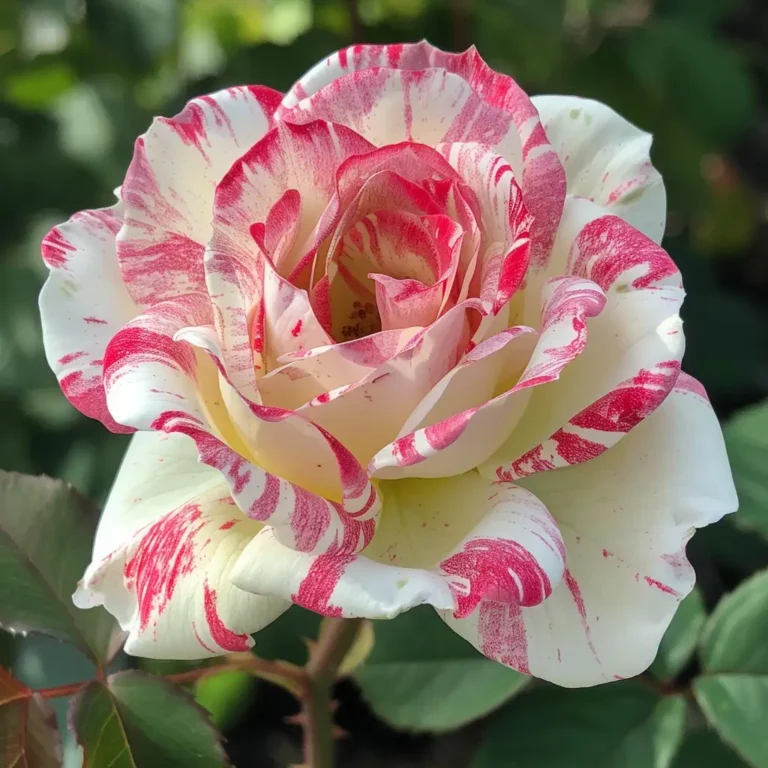Introduction
The Rio Samba Rose (Rosa ‘Rio Samba’) is a stunning hybrid tea rose known for its vibrant color changes and strong fragrance. This rose variety is popular among gardeners for its beauty and ease of cultivation.
History and Origin
The Rio Samba Rose was developed through selective breeding to create a flower with unique color transitions. Originating from hybrid tea roses, it has become a favorite due to its spectacular appearance and robust growth.
Characteristics of Rio Samba Rose
Appearance and Features
- The Rio Samba Rose boasts large, striking blooms that change color from bright yellow to deep orange and red as they mature.
- The flowers typically measure 4-5 inches in diameter, making them a prominent feature in any garden.
- The rose blooms continuously from spring through fall, ensuring a long-lasting display of color.
Growth Habits
- This rose plant usually grows to a height of 3-4 feet with a spread of 2-3 feet.
- It has a moderate growth rate, reaching full maturity in about two years.
- The plant’s vigorous growth habit and strong stems make it ideal for cutting gardens and floral arrangements.
Fragrance
- The Rio Samba Rose emits a mild, sweet fragrance that is most noticeable in the early morning and late evening.
- Its scent adds an additional sensory dimension to gardens and floral displays.
Cultivation and Care
Planting and Soil Requirements
- Ideal soil for Rio Samba Rose is well-drained loam with a pH level between 6.0 and 6.5.
- Planting should be done in a location that receives full sun for at least six hours daily.
- Proper spacing is crucial, with each plant spaced about 2-3 feet apart to allow for adequate air circulation.
Watering and Fertilizing
- Water the Rio Samba Rose deeply once a week, ensuring the soil is moist but not waterlogged.
- During hot, dry periods, increase watering frequency to maintain soil moisture.
- Use a balanced fertilizer designed for roses every 4-6 weeks during the growing season to promote healthy growth and abundant blooms.
Pruning and Maintenance
- Prune the Rio Samba Rose in early spring before new growth begins. Remove dead or damaged wood and shape the plant to encourage healthy development.
- Regular deadheading (removing spent blooms) helps stimulate continuous blooming throughout the season.
- Mulch around the base of the plant to retain soil moisture and reduce weed growth.
Pest and Disease Management
- Common pests affecting the Rio Samba Rose include aphids, spider mites, and Japanese beetles.
- Diseases such as black spot, powdery mildew, and rust can also occur.
- Regular inspection and the use of organic or chemical treatments can help manage these issues.
Uses and Benefits
Landscaping and Decorative Uses
- The Rio Samba Rose is a versatile plant that can be used in various garden settings, including flower beds, borders, and as a focal point in mixed plantings.
- It is also excellent for cutting gardens, providing beautiful blooms for indoor arrangements.
Benefits of Growing Rio Samba Rose
- Growing Rio Samba Roses adds aesthetic value to gardens with their vibrant colors and sweet fragrance.
- These roses contribute to local biodiversity by attracting pollinators such as bees and butterflies.
- Their long blooming period provides continuous visual interest and enjoyment.
FAQs
Common Questions About Rio Samba Rose
How much sunlight does Rio Samba Rose need?
- The Rio Samba Rose requires full sun for at least six hours a day to thrive.
How often should Rio Samba Rose be watered?
- Water deeply once a week, increasing frequency during hot and dry conditions.
What is the best time to plant Rio Samba Rose?
- The ideal time to plant Rio Samba Rose is in early spring or fall when temperatures are moderate.
Conclusion
The Rio Samba Rose is a spectacular addition to any garden, offering vibrant colors, a sweet fragrance, and ease of care. By following proper cultivation practices and addressing pest and disease issues, gardeners can enjoy the beauty and benefits of this unique rose variety.

